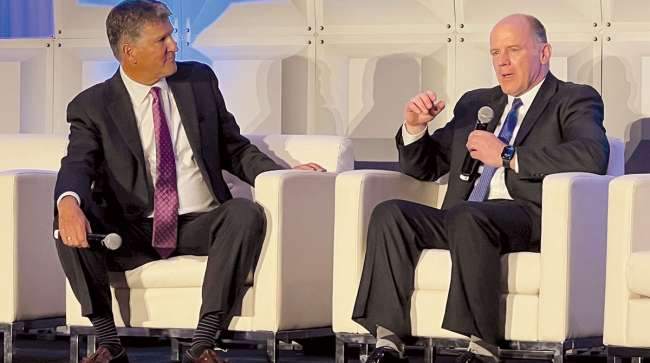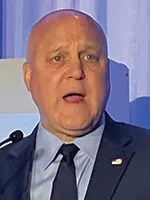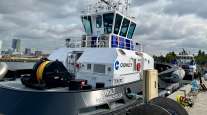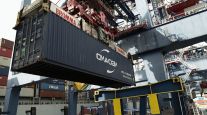Senior Reporter
Port Leaders Look to Future

[Stay on top of transportation news: Get TTNews in your inbox.]
WASHINGTON — White House Supply Chain Envoy Stephen Lyons told attendees at the American Association of Port Authorities Legislative Summit that the nation’s transportation system was severely tested during the nearly three years of turmoil caused by the COVID-19 pandemic.
“It’s a lot easier to talk about supply chains this year than it was last year. We are in a much better place,” Lyons, a retired general, said to 300 port officials attending the conference. “You’ve lived it and thanks for the extraordinary work all of you did to get us to a better place.”
Lyons was one of several high-profile speakers at the three-day conference, including Transportation Secretary Pete Buttigieg, members of Congress and others, who emphasized the importance of the nation’s ports.
Lyons said the combination of the pandemic and more than 50 years of neglect in infrastructure showed American transportation leaders the urgent need to retool the nation’s highways, roads, bridges, airports, transit systems and ports.
“The only way to recover from this is to bring the system back into balance and that takes time. It’s a deliberate effort. For the American consumer this was a real crisis of confidence and it was a significant factor in inflationary pressure,” he said.
Lyons also confirmed plans he intends to leave the Biden administration sometime in May. He said the Infrastructure Investment and Jobs Act does call for an assistant secretary of transportation for multimodal freight and he anticipates his successor will be in that role.
The bipartisan infrastructure bill calls for spending more than $19 billion on port projects and states and the private sector had said they’ll spend another $6 billion, making this the largest one-time investment in the nation’s ports.

Landrieu
White House Senior Adviser Mitch Landrieu explained to port leaders how the money is now being spent, detailing dollar amounts on some of the specific projects.
“To date, we’ve used these funds to announce more than 800 projects at ports and navigable waterways in nearly every state and territory in the U.S.” Landrieu said. “At the Houston Ship Channel we’re expanding the channel, running from Galveston into downtown Houston. They’re receiving $142 million from the infrastructure law. We’ve committed $225 million to deepen and widen the Norfolk Harbor Shipping Channel which will make navigation safer and move goods faster.”
Landrieu said it’s not only deepening of waterways where the money is being spent.
“These are projects that are coast-to-coast. In Aberdeen, Wash., we’re helping fund the construction of an additional 50,000 feet of rail to accommodate more train and railcar storage,” Landrieu said. “In Camden, N.J., we’re reconstructing nearly 3 miles of key roadway infrastructure to make it easier for trucks to get in and get out of the port, with upgraded street lights, turns and sidewalks. In Jacksonville, Fla., we’re helping to install electrified refrigerated container stacks, new hybrid-electric gantry cranes and battery-electric forklifts and helping the transition to zero-emission technologies and a clean energy future.”
Landrieu said later this year the Environmental Protection Agency will include $3 billion for clean port projects.
AAPA President and CEO Chris Connor said he and the AAPA members are very encouraged that the federal, state and private money is making its way to the nation’s ports. But he and other leaders once again called on government officials to find ways to reduce the sometimes very long permitting process, which he said drives up costs as projects are delayed, sometimes for years.
Want more news? Listen to today's daily briefing above or go here for more info
“It makes no sense to fund the federal government’s largest construction agency, the Army Corps of Engineers, the way it is done today. Especially when it returns $14 in economic value for every dollar it spends,” Connor said. “We have some obstacles when it comes to modernizing our ports. Getting shovels in the ground is a formidable challenge.”
Connor says the association is fully committed to supporting legislation which he said could streamline the permitting process and without impacting environmental regulations.
With port leaders also closely watching the ongoing West Coast labor negotiations between the International Longshore and Warehouse Union and management’s representative, the Pacific Maritime Association, the attendees received some encouraging news about the status of the10-month-old talks. It was revealed during one panel discussion that the two sides have only recently begun to tackle economic issues, after spending a considerable amount of time ironing out a jurisdictional issue between unions.
“We had a jurisdictional issue that was quite complex with litigation in the background and it took a long time to work through,” said George Pasha, CEO of port consulting organization The Pasha Group. “We’re seeing this negotiation just getting started in its traditional form and I’m optimistic. Hopefully they’ll get this done in the next couple of months.”




